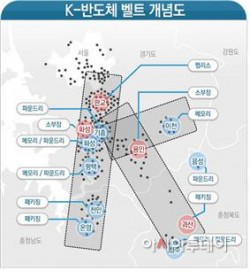 |
| Source: The Ministry of Trade, Industry and Energy |
AsiaToday reporter Choi Won-young
Samsung Electronics and SK Hynix will invest 510 trillion won ($458.1 billion) in semiconductors for 10 years while the government will provide tax cuts and cheap loans to establish the world’s largest semiconductor supply chain, the so-called ‘K-Semiconductor Belt’. The new semiconductor cluster will cover the Gyeonggi provincial areas of Pangyo and Yongin.
President Moon Jae-in announced the ‘K-Semiconductor blueprint’ aimed at making South Korea the world’s No. 1 semiconductor powerhouse by 2030, at Samsung’s chip manufacturing center in Pyeongtaek, Gyeonggi Province, on Thursday. The event was participated in by officials from the government and private sector including Deputy Prime Minister for Economic Affairs Hong Nam-ki, Deputy Prime Minister for Social Affairs Yoo Eun-hye, Samsung Electronics Vice Chairman Kim Ki-nam and SK Hynix Vice Chairman Park Jung-ho. Yang Hyang-ja, the chair of the ruling Democratic Party’s special committee on semiconductor technology, as well as Gyeonggi Governor Lee Jae-myung attended the event.
During the event, Moon vowed to build the world’s best semiconductor manufacturing base and lead the global supply chain. The key of the blueprint is creating the “K-Chip Belt” in the western part of the country incorporating Pangyo, Giheung, Hwaseong, Pyeongtaek and Onyang, and the central region connecting Icheon, Yongin and Cheongju. The belt will cover every scope of the semiconductor business – manufacturing, materials, components and equipment, and design. If the project moves forward smoothly, the government expects the country’s chip exports to more than double to $200 billion by 2030 from last year’s total of $99.2 billion, with a workforce of 270,000.
To this end, the country’s chipmakers will invest over 510 trillion won in total over the next 10 years. Samsung said it will spend an additional 38 trillion won to become a leader in both the memory and system semiconductor sectors, bringing its total investment to 171 trillion won. SK hynix said it will invest 100 trillion won in Icheon and Cheongju by 2030, and additionally invest 120 trillion won over the next 10 years to build a new semiconductor complex in Yongin. In addition, packaging company Nepes plans to invest in building a cutting-edge packaging platform, while AI chip start-up Rebellions will invest in the Pangyo fabless valley.
The government will offer tax benefits and subsidies to local chipmakers. It will provide tax credits of up to 50 percent for investment in R&D, and up to 20 percent for facility investment. It will provide a special financial support program of over 1 trillion won to support technology development by chipmakers and shorten the period of various types of license approvals. It aims to foster a 36,000-strong semiconductor workforce for the next 10 years.
#chip supply #K-Semiconductor blueprint #semiconductor #Samsung Electronics #SK hynix
Copyright by Asiatoday
Most Read
-
1
-
2
-
3
-
4
-
5
-
6
-
7





















